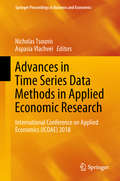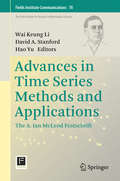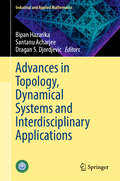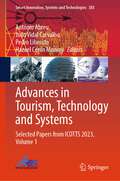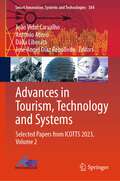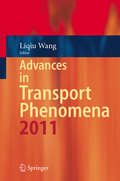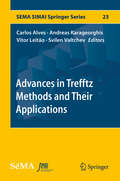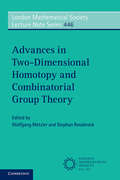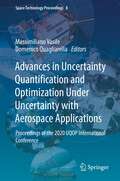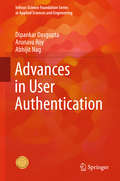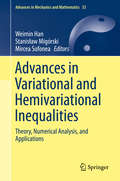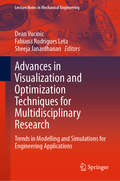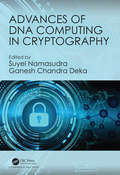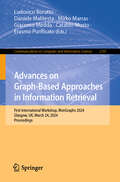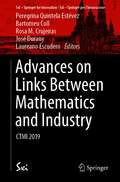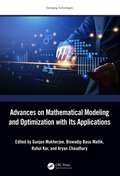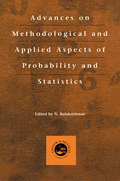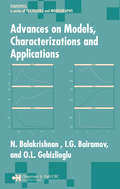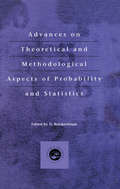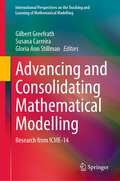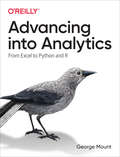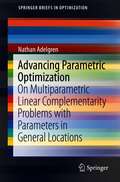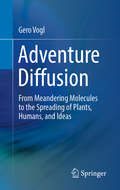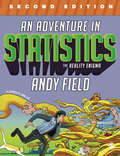- Table View
- List View
Advances in Time Series Data Methods in Applied Economic Research: International Conference On Applied Economics (icoae) 2018 (Springer Proceedings in Business and Economics)
by Nicholas Tsounis Aspasia VlachveiThis conference proceedings volume presents advanced methods in time series estimation models that are applicable various areas of applied economic research such as international economics, macroeconomics, microeconomics, finance economics and agricultural economics. Featuring contributions presented at the 2018 International Conference on Applied Economics (ICOAE) held in Warsaw, Poland, this book presents contemporary research using applied econometric method for analysis as well as country specific studies with potential implications on economic policy. Applied economics is a rapidly growing field of economics that combines economic theory with econometrics to analyse economic problems of the real world usually with economic policy interest. ICOAE is an annual conference started in 2008 with the aim to bring together economists from different fields of applied economic research in order to share methods and ideas. Approximately 150 papers are submitted each year from about 40 countries around the world. The goal of the conference and the enclosed papers is to allow for an exchange of experiences with different applied econometric methods and to promote joint initiatives among well-established economic fields such as finance, agricultural economics, health economics, education economics, international trade theory and management and marketing strategies. Featuring global contributions, this book will be of interest to researchers, academics, professionals and policy makers in the field of applied economics and econometrics.
Advances in Time Series Methods and Applications: The A. Ian McLeod Festschrift (Fields Institute Communications #78)
by Hao Yu Wai Keung Li David A. StanfordThis volume reviews and summarizes some of A. I. McLeod's significant contributions to time series analysis. It also contains original contributions to the field and to related areas by participants of the festschrift held in June 2014 and friends of Dr. McLeod. Covering a diverse range of state-of-the-art topics, this volume well balances applied and theoretical research across fourteen contributions by experts in the field. It will be of interest to researchers and practitioners in time series, econometricians, and graduate students in time series or econometrics, as well as environmental statisticians, data scientists, statisticians interested in graphical models, and researchers in quantitative risk management.
Advances in Topology, Dynamical Systems and Interdisciplinary Applications (Industrial and Applied Mathematics)
by Bipan Hazarika Santanu Acharjee Dragan S. DjordjevicThis book contains selected chapters on topology and dynamical systems and their interdisciplinary applications. Targeting researchers in interdisciplinary areas, the book covers contemporary interdisciplinary topics in topology and dynamical systems, such as closure functions, Partially Negative Dimensional Product (PNDP) manifolds, Khalimsky topological subspaces, neutrosophic topological space, ideal topological spaces, relator spaces, predator–prey symbiosis, cosmological models, and nanofluids.
Advances in Tourism, Technology and Systems: Selected Papers from ICOTTS 2023, Volume 1 (Smart Innovation, Systems and Technologies #383)
by António Abreu João Vidal Carvalho Pedro Liberato Hazael Cerón MonroyThis book features a collection of high-quality research papers presented at the International Conference on Tourism, Technology and Systems (ICOTTS 2023), held at Anáhuac University, Bacalar, Mexico, from 2 to 4 November 2023. The book is divided into two volumes, and it covers the areas of technology in tourism and the tourist experience, generations and technology in tourism, digital marketing applied to tourism and travel, mobile technologies applied to sustainable tourism, information technologies in tourism, digital transformation of tourism business, e-tourism and tourism 2.0, big data and management for travel and tourism, geotagging and tourist mobility, smart destinations, robotics in tourism, and information systems and technologies.
Advances in Tourism, Technology and Systems: Selected Papers from ICOTTS 2023, Volume 2 (Smart Innovation, Systems and Technologies #384)
by João Vidal Carvalho António Abreu Dália Liberato José Angel Díaz RebolledoThis book features a collection of high-quality research papers presented at the International Conference on Tourism, Technology and Systems (ICOTTS 2023), held at Anáhuac University, Bacalar, Mexico, from 2 to 4 November 2023. The book is divided into two volumes, and it covers the areas of technology in tourism and the tourist experience, generations and technology in tourism, digital marketing applied to tourism and travel, mobile technologies applied to sustainable tourism, information technologies in tourism, digital transformation of tourism business, e-tourism and tourism 2.0, big data and management for travel and tourism, geotagging and tourist mobility, smart destinations, robotics in tourism, and information systems and technologies.
Advances in Transport Phenomena 2011 (Advances in Transport Phenomena #3)
by Liqiu WangThis new volume of the annual review "Advances in Transport Phenomena" series contains three in-depth review articles on the microfluidic fabrication of vesicles, the dielectrophoresis field-flow fractionation for continuous-flow separation of particles and cells in microfluidic devices, and the thermodynamic analysis and optimization of heat exchangers, respectively.
Advances in Trefftz Methods and Their Applications (SEMA SIMAI Springer Series #23)
by Carlos Alves Andreas Karageorghis Vitor Leitão Svilen ValtchevIn this book we gather recent mathematical developments and engineering applications of Trefftz methods, with particular emphasis on the Method of Fundamental Solutions (MFS). These are true meshless methods that have the advantage of avoiding the need to set up a mesh altogether, and therefore going beyond the reduction of the mesh to a boundary. These Trefftz methods have advantages in several engineering applications, for instance in inverse problems where the domain is unknown and some numerical methods would require a remeshing approach.Trefftz methods are also known to perform very well with regular domains and regular data in boundary value problems, achieving exponential convergence. On the other hand, they may also under certain conditions, exhibit instabilities and lead to ill-conditioned systems. This book is divided into ten chapters that illustrate recent advances in Trefftz methods and their application to engineering problems. The first eight chapters are devoted to the MFS and variants whereas the last two chapters are devoted to related meshless engineering applications. Part of these selected contributions were presented in the 9th International Conference on Trefftz Methods and 5th International Conference on the MFS, held in 2019, July 29-31, in Lisbon, Portugal.
Advances in Two-Dimensional Homotopy and Combinatorial Group Theory (London Mathematical Society Lecture Note Series #446)
by Wolfgang Metzler Stephan RosebrockThis volume presents the current state of knowledge in all aspects of two-dimensional homotopy theory. Building on the foundations laid a quarter of a century ago in the volume Two-dimensional Homotopy and Combinatorial Group Theory (LMS 197), the editors here bring together much remarkable progress that has been obtained in the intervening years. And while the fundamental open questions, such as the Andrews-Curtis Conjecture and the Whitehead asphericity problem remain to be (fully) solved, this book will provide both students and experts with an overview of the state of the art and work in progress. Ample references are included to the LMS 197 volume, as well as a comprehensive bibliography bringing matters entirely up to date.
Advances in Uncertainty Quantification and Optimization Under Uncertainty with Aerospace Applications: Proceedings of the 2020 UQOP International Conference (Space Technology Proceedings #8)
by Massimiliano Vasile Domenico QuagliarellaThe 2020 International Conference on Uncertainty Quantification & Optimization gathered together internationally renowned researchers in the fields of optimization and uncertainty quantification. The resulting proceedings cover all related aspects of computational uncertainty management and optimization, with particular emphasis on aerospace engineering problems. The book contributions are organized under four major themes: Applications of Uncertainty in Aerospace & EngineeringImprecise Probability, Theory and ApplicationsRobust and Reliability-Based Design Optimisation in Aerospace EngineeringUncertainty Quantification, Identification and Calibration in Aerospace Models This proceedings volume is useful across disciplines, as it brings the expertise of theoretical and application researchers together in a unified framework.
Advances in User Authentication (Infosys Science Foundation Series)
by Dipankar Dasgupta Arunava Roy Abhijit NagThis book is dedicated to advances in the field of user authentication. The book covers detailed description of the authentication process as well as types of authentication modalities along with their several features (authentication factors). It discusses the use of these modalities in a time-varying operating environment, including factors such as devices, media and surrounding conditions, like light, noise, etc. The book is divided into several parts that cover descriptions of several biometric and non-biometric authentication modalities, single factor and multi-factor authentication systems (mainly, adaptive), negative authentication system, etc. Adaptive strategy ensures the incorporation of the existing environmental conditions on the selection of authentication factors and provides significant diversity in the selection process. The contents of this book will prove useful to practitioners, researchers and students. The book is suited to be used a text in advanced/graduate courses on User Authentication Modalities. It can also be used as a textbook for professional development and certification coursework for practicing engineers and computer scientists.
Advances in Variational and Hemivariational Inequalities: Theory, Numerical Analysis, and Applications (Advances in Mechanics and Mathematics #33)
by Mircea Sofonea Stanisław Migórski Weimin HanThis volume is comprised of articles providing new results on variational and hemivariational inequalities with applications to Contact Mechanics unavailable from other sources. The book will be of particular interest to graduate students and young researchers in applied and pure mathematics, civil, aeronautical and mechanical engineering, and can be used as supplementary reading material for advanced specialized courses in mathematical modeling. New results on well posedness to stationary and evolutionary inequalities and their rigorous proofs are of particular interest to readers. In addition to results on modeling and abstract problems, the book contains new results on the numerical methods for variational and hemivariational inequalities.
Advances in Visualization and Optimization Techniques for Multidisciplinary Research: Trends in Modelling and Simulations for Engineering Applications (Lecture Notes in Mechanical Engineering)
by Dean Vucinic Fabiana Rodrigues Leta Sheeja JanardhananThis volume presents several multidisciplinary approaches to the visual representation of data acquired from experiments. As an expansion of these approaches, it is also possible to include data examination generated by mathematical-physical modeling. Imaging Systems encompass any subject related to digital images, from fundamental requirements for a correct image acquisition to computational algorithms that make it possible to obtain relevant information for image analysis. In this context, the book presents selected contributions of a special session at the Conference on Advanced Computational Engineering and Experimenting (ACE-X) 2016.
Advances of DNA Computing in Cryptography
by Suyel Namasudra Ganesh Chandra DekaThis book discusses the current technologies of cryptography using DNA computing. Various chapters of the book will discuss the basic concepts of cryptography, steganography, basic concepts of DNA and DNA computing, approaches of DNA computing in cryptography, security attacks, practical implementaion of DNA computing, applications of DNA computing in the cloud computing environment, applications of DNA computing for big data, etc. It provides a judicious mix of concepts, solved examples and real life case studies.
Advances on Graph-Based Approaches in Information Retrieval: First International Workshop, IRonGraphs 2024, Glasgow, UK, March 24, 2024, Proceedings (Communications in Computer and Information Science #2197)
by Ludovico Boratto Daniele Malitesta Mirko Marras Giacomo Medda Cataldo Musto Erasmo PurificatoThis book constitutes the refereed proceedings of the First International Workshop on Graph-Based Approaches in Information Retrieval, IRonGraphs 2024, held in Glasgow, UK, on March 24, 2024. The 6 full papers included in this book were carefully reviewed and selected from 14 submissions. They focus on diverse novel contributions, with presentations on knowledge-aware graph-based recommender systems using user-based semantic features filtering, source-target node distance impacts on adversarial attacks in social network recommendations.
Advances on Links Between Mathematics and Industry: CTMI 2019 (SxI - Springer for Innovation / SxI - Springer per l'Innovazione #15)
by Peregrina Quintela Estévez Bartomeu Coll Rosa M. Crujeiras José Durany Laureano EscuderoThis book results from the talks presented at the First Conference on Transfer between Mathematics & Industry (CTMI 2019). Its goal is to promote and disseminate the mathematical tools for Statistics & Big Data, MSO (Modeling, Simulation and Optimization) and their industrial applications. In this volume, the reader will find innovative advances in the automotive, energy, railway, logistics, and materials sectors. In addition, Advances CTMI 2019 promotes the opening of new research lines aiming to provide suitable solutions for the industrial and societal challenges. Fostering effective interaction between Academia and Industry is our main purpose with this book. CTMI conferences are one of the main forums where significant advances in industrial mathematics are presented, bringing together outstanding leaders from business, science and Academia to promote the use of mathematics for an innovative industry.
Advances on Mathematical Modeling and Optimization with Its Applications (Emerging Technologies)
by Gunjan Mukherjee Biswadip Basu Mallik Rahul Kar Aryan ChaudharyAdvances on Mathematical Modeling and Optimization with Its Applications discusses optimization, equality, and inequality constraints and their application in the versatile optimizing domain. It further covers non-linear optimization methods such as global optimization, and gradient-based non-linear optimization, and their applications. Discusses important topics including multi-component differential equations, geometric partial differential equations, and computational neural systems Covers linear integer programming and network design problems, along with an application of the mixed integer problems Discusses constrained and unconstrained optimization, equality, and inequality constraints, and their application in the versatile optimizing domain Elucidates the application of statistical models, probability models, and transfer learning concepts Showcases the importance of multi-attribute decision modeling in the domain of image processing and soft computing The text is primarily for senior undergraduate and graduate students, and academic researchers in the fields of mathematics, statistics, and computer science.
Advances on Methodological and Applied Aspects of Probability and Statistics
by N. BalakrishnanThis is one of two volumes that sets forth invited papers presented at the International Indian Statistical Association Conference. This volume emphasizes advancements in methodology and applications of probability and statistics. The chapters, representing the ideas of vanguard researchers on the topic, present several different subspecialties, including applied probability, models and applications, estimation and testing, robust inference, regression and design and sample size methodology. The text also fully describes the applications of these new ideas to industry, ecology, biology, health, economics and management. Researchers and graduate students in mathematical analysis, as well as probability and statistics professionals in industry, will learn much from this volume.
Advances on Models, Characterizations and Applications
by N. Balakrishnan I. G. Bairamov O. L. GebizliogluStatistical distributions are one of the most important applied mathematical tools across a wide spectrum of disciplines, including engineering, biological sciences, and health and social sciences. Since they are used to model observed data and ultimately to develop inferential procedures, understanding the properties of statistical distributions i
Advances on Theoretical and Methodological Aspects of Probability and Statistics
by N. BalakrishnanAt the International Indian Statistical Association Conference, held at McMaster University in Ontario, Canada, participants focused on advancements in theory and methodology of probability and statistics. This is one of two volumes containing invited papers from the meeting. The 32 chapters deal with different topics of interest, including stochastic processes and inference, distributions and characterizations, inference, Bayesian inference, selection methods, regression methods, and methods in health research. The text is ideal for applied mathematicians, statisticians, and researchers in the field.
Advancing and Consolidating Mathematical Modelling: Research from ICME-14 (International Perspectives on the Teaching and Learning of Mathematical Modelling)
by Gilbert Greefrath Susana Carreira Gloria Ann StillmanThis edited volume presents applications and modelling as a world-renowned sub-field of research in mathematics education. It includes the discussion on students’ development of modelling competency through the teaching of applications and modelling. The teaching of mathematical modelling is considered from different perspectives, such as mathematical, pedagogical-didactical perspectives and critical-societal or socio-political perspectives. Assessment practices (local, regional or international) of modelling activities and difficulties with modelling activities at school and university levels, respectively, are discussed. Use of technology and other resources in modelling activities and their impact on the modelling processes are included in the considerations. Teaching practices, teacher education and professional development programs concerning the integration of applications and modelling in school and university mathematics programs are developed in this context.
Advancing into Analytics: From Excel To Python And R
by George MountData analytics may seem daunting, but if you're an experienced Excel user, you have a unique head start. With this hands-on guide, intermediate Excel users will gain a solid understanding of analytics and the data stack. By the time you complete this book, you'll be able to conduct exploratory data analysis and hypothesis testing using a programming language.Exploring and testing relationships are core to analytics. By using the tools and frameworks in this book, you'll be well positioned to continue learning more advanced data analysis techniques. Author George Mount, founder and CEO of Stringfest Analytics, demonstrates key statistical concepts with spreadsheets, then pivots your existing knowledge about data manipulation into R and Python programming.This practical book guides you through:Foundations of analytics in Excel: Use Excel to test relationships between variables and build compelling demonstrations of important concepts in statistics and analyticsFrom Excel to R: Cleanly transfer what you've learned about working with data from Excel to RFrom Excel to Python: Learn how to pivot your Excel data chops into Python and conduct a complete data analysis
Advancing Parametric Optimization: On Multiparametric Linear Complementarity Problems with Parameters in General Locations (SpringerBriefs in Optimization)
by Nathan AdelgrenThe theory presented in this work merges many concepts from mathematical optimization and real algebraic geometry. When unknown or uncertain data in an optimization problem is replaced with parameters, one obtains a multi-parametric optimization problem whose optimal solution comes in the form of a function of the parameters.The theory and methodology presented in this work allows one to solve both Linear Programs and convex Quadratic Programs containing parameters in any location within the problem data as well as multi-objective optimization problems with any number of convex quadratic or linear objectives and linear constraints. Applications of these classes of problems are extremely widespread, ranging from business and economics to chemical and environmental engineering. Prior to this work, no solution procedure existed for these general classes of problems except for the recently proposed algorithms
Adventure Diffusion: From Meandering Molecules to the Spreading of Plants, Humans, and Ideas
by Gero VoglThis easy-to read book looks at the many ways in which diffusion bears on processes that involve dispersion, starting from the Brownian motion of molecules, covering the invasion of exotic plants, migration of populations, epidemics, and extending to the spreading of languages and ideas. Recently, there has been a growing interest in understanding migrations, diffusion and spreading outside the “hard” natural sciences of physics and chemistry, for example the spreading of plants introduced as a result of globalization. Another fascinating story is that of human migration in the distant past, i.e. the immigration of our ancestors who brought agriculture from the Near East, or the fast spread of the Palaeo-Indians into the Americas after the end of the Ice Age. Likewise, the spread of languages in the past, and even more so the current spread and retreat of languages will be described here in terms of diffusion. By understanding these principles, there is hope that some of the less common languages that are threatened by globalization can be saved. Another important implication discussed by the author concerns the outbreak of epidemics; these may be mitigated if we understand their spreading mechanism. Last but not least the spreading of ideas and innovations, a process which changes the world sometimes faster than we wish, can also be usefully described in this picture.
An Adventure in Statistics: The Reality Enigma
by Andy FieldAPEX Award 2023 for Publication Excellence: Print Media - Education & Training Shortlisted for the British Psychological Society Book Award 2017 Shortlisted for the British Book Design and Production Awards 2016 Shortlisted for the Association of Learned & Professional Society Publishers Award for Innovation in Publishing 2016 Now in its second edition, An Adventure in Statistics: The Reality Enigma by best-selling author and award-winning teacher Andy Field offers a better way to learn statistics. It combines rock-solid statistics coverage with compelling visual storytelling to address the conceptual difficulties that students learning statistics for the first time often encounter in introductory courses. Students are guided away from rote memorization towards independent, critical thinking and problem solving. This essential foundation to understanding statistics is woven into the unique action-packed story of Zach, who thinks, processes information and faces challenges to his understanding in the same way as a statistics novice. Illustrated with stunning, graphic novel-style art and featuring Socratic dialogue, the story captivates readers as it introduces them to concepts, eliminating potential statistics anxiety. No previous statistics knowledge is presumed, and no use of data analysis software is required – everything you would expect for an introductory course is covered but with a contemporary twist, arming students with a strong grounding in understanding classical and Bayesian approaches to data analysis. With its unique combination of story, concepts and terminology, this complete introduction to statistics from bestselling author Andy Field breaks the mould to present a statistical tale like no other. Stay connected Join us on Facebook and share your experiences with Andy’s texts, check out news, access free stuff, see photos, watch videos, learn about competitions, and much more.
An Adventure in Statistics: The Reality Enigma
by Andy FieldAPEX Award 2023 for Publication Excellence: Print Media - Education & Training Shortlisted for the British Psychological Society Book Award 2017 Shortlisted for the British Book Design and Production Awards 2016 Shortlisted for the Association of Learned & Professional Society Publishers Award for Innovation in Publishing 2016 Now in its second edition, An Adventure in Statistics: The Reality Enigma by best-selling author and award-winning teacher Andy Field offers a better way to learn statistics. It combines rock-solid statistics coverage with compelling visual storytelling to address the conceptual difficulties that students learning statistics for the first time often encounter in introductory courses. Students are guided away from rote memorization towards independent, critical thinking and problem solving. This essential foundation to understanding statistics is woven into the unique action-packed story of Zach, who thinks, processes information and faces challenges to his understanding in the same way as a statistics novice. Illustrated with stunning, graphic novel-style art and featuring Socratic dialogue, the story captivates readers as it introduces them to concepts, eliminating potential statistics anxiety. No previous statistics knowledge is presumed, and no use of data analysis software is required – everything you would expect for an introductory course is covered but with a contemporary twist, arming students with a strong grounding in understanding classical and Bayesian approaches to data analysis. With its unique combination of story, concepts and terminology, this complete introduction to statistics from bestselling author Andy Field breaks the mould to present a statistical tale like no other. Stay connected Join us on Facebook and share your experiences with Andy’s texts, check out news, access free stuff, see photos, watch videos, learn about competitions, and much more.
